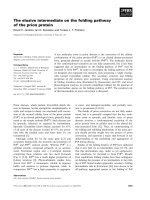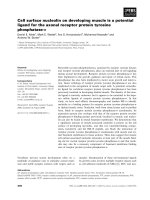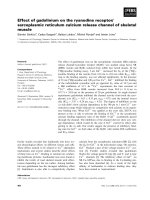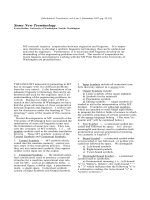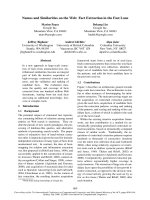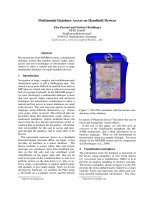báo cáo khoa học: "Shedding new light on genetic dark matter" pdf
Bạn đang xem bản rút gọn của tài liệu. Xem và tải ngay bản đầy đủ của tài liệu tại đây (238.8 KB, 3 trang )
Background
e past three decades of studies have unveiled some of
the genetic underpinnings of human disease. For complex
diseases, those with obscure genetic roots, discoveries
have accelerated recently owing to a bloom of genome-
wide association studies (GWASs) [1]. Nevertheless, even
for the most successful cases (such as inflammatory and
ulcerative bowel disease [2,3]), discoveries account for
only a fraction, often small, of the disease’s heritability.
ese yet to be discovered genetic variants comprise the
‘missing heritability’ or the genetic ‘dark matter’ for
disease.
State of dark matter
Heritability, the proportion of trait variability explained
by genetic factors, has two somewhat different meanings.
Narrow-sense heritability involves only the additive
effects of genes. Broad-sense heritability involves both
additive and non-additive effects. e difference between
the two makes a difference when hunting for dark matter.
If genetic variation were all to act additively, the best
predictor of an offspring’s trait value would be the
average of his/her parents’ values. Human height is an
excellent example, after adjusting for gender. Hunting for
dark matter for a trait such as human height will be more
straightforward than for a disease such as schizophrenia,
for which the evidence for substantial gene-gene inter-
action is compelling [4]. Yet when researchers refer to
heritability of human height, they implicitly mean
narrow-sense heritability; for schizophrenia, it is
heritability in a much broader sense.
Why should we care about the genetic basis of disease?
Greater understanding of the genetics equals greater
understanding of molecular etiology and, with it,
eventually more cogent treatments. However, the origins
of some human diseases, especially those of the mind,
can be mysterious. For diseases of the mind, few environ-
mental or genetic risk factors are understood; instead the
hope is that identified genetic factors will lead to a subtler
understanding of why diseases such as schizophrenia
arise and how they can be treated effectively. Even for
cardiovascular disease, for which environmental risk
factors are well characterized, new insights into its
genetics could produce more targeted treatment. is
leads to the other expectation - that greater genetic
knowledge will pave the way for ‘personalized’ medicine.
e rapid technological advances in genomics will soon
make it feasible to sequence whole genomes at relatively
low cost. e idea that each individual will have
meaningful sequence variation in their medical records
and will have interventions tailored to their risk profile
and likely treatment response is quite appealing. e goal
of personalized medicine, however, is hindered because
so much molecular etiology remains in the dark.
One way to explain more of the dark matter is to
develop more efficient ways to use existing data.
Naukkarinen et al. [5] develop an innovative approach
that integrates gene expression and genotype data. ey
apply these ideas to a GWAS of obesity, as measured by
body mass index (BMI). Studies estimate BMI’s
heritability at 45 to 85%, but identified genetic variants
Abstract
Discoveries from genome-wide association studies
have contributed to our knowledge of the genetic
etiology of many complex diseases. However, these
account for only a small fraction of each disease’s
heritability. Here, we comment on approaches
currently available to uncover more of the genetic ‘dark
matter,’ including an approach introduced recently by
Naukkarinen and colleagues. These authors propose a
method for distinguishing between gene expression
driven by genetic variation and that driven by non-
genetic factors. This dichotomy allows investigators to
focus statistical tests and further molecular analyses on
a smaller set of genes, thereby discovering new genetic
variation aecting risk for disease. We need more
methods like this one if we are to shed a powerful light
on dark matter. By enhancing our understanding of
molecular genetic etiology, such methods will help
us to understand disease processes better and will
advance the promise of personalized medicine.
© 2010 BioMed Central Ltd
Shedding new light on genetic dark matter
Nadine Melhem and Bernie Devlin*
CO M M E N TARY
*Correspondence:
Department of Psychiatry, University of Pittsburgh School of Medicine, 3811
O’Hara St, Pittsburgh, PA 15213, USA
Melhem and Devlin Genome Medicine 2010, 2:79
/>© 2010 BioMed Central Ltd
explain about 1% of the total variance [6]. To discover
more variants, the authors [5] examined gene expression
of adipose tissue in a sample of monozygotic (MZ) twins
discordant for BMI and in a sample of unrelated
individuals. Because MZ twins are genetically identical,
or nearly so, the authors reasoned that genes showing
expression differences between twins are ‘reactive’ genes
with differences that are due to regulatory or epigenetic
changes in response to environmental factors. By
contrast, genes uncovered in unrelated individuals are a
combination of reactive and genetically ‘causal’ genes. By
contrasting results from the unrelated sample and
discordant MZ twins, the authors identified 27 causal
genes that were differentially regulated. ey then tested
197 single nucleotide polymorphisms (SNPs) falling in
and around these genes in a sample of 21,000 subjects.
ey discovered a significant excess of small P-values in
this set of SNPs. Neither the set of SNPs defined by
reactive genes nor the individual SNPs in the reactive set
were associated with BMI. Notably, this work identifies a
new gene, F13A1, which encodes the coagulation factor
XIII A chain, with variation that affects BMI. is gene
has also been identified by meta-analysis of 12 studies of
venous thromboembolism [7]. Obesity is well known to
predispose to vein thromboses; however, the study of
Naukkarinen et al. [5] reveals a potential biological path-
way for the relationship between obesity, thrombosis and
cardiovascular risk.
e methods advanced by Naukkarinen and colleagues
[5] require discordant MZ twins, which were available for
BMI. is experimental design could prove highly infor-
ma tive for similar quantitative traits, for which extremes
are easily identified and by which the pathology or
phenotype of interest is defined. For some diseases,
especially diseases of the brain, quantitative traits that
map precisely onto risk are not yet available. In addition,
because reactive genes are environment-dependent,
successful implementation of this design might require a
sample exposed to a homogeneous environment, limiting
its generality. Regardless, this study shows how inno-
vative research can cast more light on dark matter.
Moreover, the study design could also inform us about
pathways of correlated gene expression and how much
these correlations are influenced by genetic and
environmental variation.
Many other methods and designs are available to
illuminate dark matter [8-15]. One appealing approach
teams gene-expression results with genome-wide asso-
cia tion data to produce targeted hypothesis tests [8]. One
possibility is to organize tests by expression quantitative
trait loci affecting genes in pathways meaningful for the
disease. Statistical methods for targeted testing are
available, whether on the basis of prior information of the
likelihood of an association between a SNP and the
phenotype or on the basis of plausible disease pathways
[9,10]. Genetic variants with parental origin effects, or
whose effects depend on the parent from whom they
were inherited, could be part of the dark matter; methods
are now available to determine the parental origin of
alleles and haplotypes even in the absence of genotyped
parents [13]. Studies of copy number variants and their
inheritance in families could also reveal insight into
plausible biological pathways for disease [14,15]. It is also
safe to say that rare variants account for some of the dark
matter [16], possibly the majority of it in some cases.
Next-generation sequencing promises to fill some of our
void in knowledge by identifying more penetrant but
rarer variants.
Other approaches are less illuminating. Let’s reconsider
human height. We know numerous rare variants and
about 50 common variants that have an impact on height.
us far, known genetics account for roughly 5% of the
variance. Using many SNPs from GWAS analysis that are
not significantly associated with height, Yang et al. [17]
estimated the proportion of variance in height explained
by SNPs as 0.45 and even got close to the heritability
estimate of 0.84 after correcting for incomplete linkage
disequilibrium between SNPs genotyped and causal
variants. In spirit, this approach [17] is similar to the
allele score method [18], which seeks a predictive model
for disease status on the basis of thousands of SNPs with
modest evidence for association. If their results are
correct, both studies [17,18] suggest that the effects of
SNPs are small and will be difficult or impossible to
detect from simple analyses of GWASs, at least for
current sample sizes [19]. ese intriguing approaches
have some drawbacks: they shed no new light on the
molecular etiology of phenotype; and inherent in the
calculations are assumptions that could prove difficult to
validate.
We all recognize the hidden biases that inflate estimates
of heritability. ere are other complex pathways for the
transmission of a phenotype across generations without
the transmission of a specific common or rare variant,
namely through epigenetic factors that can result in the
inheritance of gene expression patterns without an
alteration of the DNA sequence [20]. Gene-environment
interactions could also affect the estimates of heritability
and when they are in play, they can explain as much of
the variance in the phenotype as genetic factors [21].
Conclusions
Concerted effort will almost surely be required to under-
stand the genetic architecture of most complex diseases.
Naukkarinen et al.’s [5] novel study design illustrates the
impact that concerted effort can have in advancing our
knowledge of the genetic etiology of such diseases. ere
remains ample room for novel analytic methods and
Melhem and Devlin Genome Medicine 2010, 2:79
/>Page 2 of 3
study designs to shed light on the genetic dark matter of
disease. It is entirely possible, 10 years hence, that we will
realize that much of the missing heritability was hiding in
plain sight in common variants.
Abbreviations
GWAS, genome-wide association study; MZ, monozygotic; SNP, single
nucleotide polymorphism.
Competing interests
The authors declare that they have no competing interests.
Authors’ contributions
The authors contributed equally to the writing and preparation of this
commentary.
Authors’ information
BD is Associate Professor of Psychiatry and Human Genetics, University
of Pittsburgh School of Medicine, Pittsburgh. His background and area
of expertise is statistical genetics. NM is Assistant Professor of Psychiatry,
University of Pittsburgh School of Medicine, Pittsburgh. Her background and
areas of expertise are psychiatric epidemiology and statistical genetics.
Acknowledgements
This work was supported by R01 grants (MH057881, BD) and a K01 grant
(MH077930, NM) from the National Institute of Mental Health. The National
Institute of Mental Health did not participate in the preparation, review or
approval of the manuscript.
Published: 21 October 2010
References
1. Manolio TA, Collins FS, Cox NJ, Goldstein DB, Hindor LA, Hunter DJ,
McCarthy MI, Ramos EM, Cardon LR, Chakravarti A, Cho JH, Guttmacher AE,
Kong A, Kruglyak L, Mardis E, Rotimi CN, Slatkin M, Valle D, Whittemore AS,
Boehnke M, Clark AG, Eichler EE, Gibson G, Haines JL, Mackay TF, McCarroll SA,
Visscher PM: Finding the missing heritability of complex diseases. Nature
2009, 461:747-753.
2. McGovern DP, Gardet A, Törkvist L, Goyette P, Essers J, Taylor KD, Neale BM,
Ong RT, Lagacé C, Li C, Green T, Stevens CR, Beauchamp C, Fleshner PR,
Carlson M, D’Amato M, Halfvarson J, Hibberd ML, Lördal M, Padyukov L,
Andriulli A, Colombo E, Latiano A, Palmieri O, Bernard EJ, Deslandres C,
Hommes DW, de Jong DJ, Stokkers PC, Weersma RK, et al.: Genome-wide
association identies multiple ulcerative colitis susceptibility loci. Nat
Genet 2010, 42:332-337.
3. Imielinski M, Baldassano RN, Griths A, Russell RK, Annese V, Dubinsky M,
Kugathasan S, Bradeld JP, Walters TD, Sleiman P, Kim CE, Muise A, Wang K,
Glessner JT, Saeed S, Zhang H, Frackelton EC, Hou C, Flory JH, Otieno G,
Chiavacci RM, Grundmeier R, Castro M, Latiano A, Dallapiccola B, Stempak J,
Abrams DJ, Taylor K, McGovern D; Western Regional Alliance for Pediatric IBD,
et al.: Common variants at ve new loci associated with early-onset
inammatory bowel disease. Nat Genet 2009, 41:1335-1340.
4. Risch N: Linkage strategies for genetically complex traits. I. Multilocus
models. Am J Hum Genet 1990, 46:222-228.
5. Naukkarinen J, Surakka I, Pietiläinen KH, Rissanen A, Salomaa V, Ripatti S,
Yki-Järvinen H, van Duijn CM, Wichmann HE, Kaprio J, Taskinen MR, Peltonen
L, ENGAGE Consortium: Use of genome-wide expression data to mine the
“Gray Zone” of GWA studies leads to novel candidate obesity genes. PLoS
Genet 2010, 6:e1000976.
6. Frayling TM, Timpson NJ, Weedon MN, Zeggini E, Freathy RM, Lindgren CM,
Perry JR, Elliott KS, Lango H, Rayner NW, Shields B, Harries LW, Barrett JC, Ellard
S, Groves CJ, Knight B, Patch AM, Ness AR, Ebrahim S, Lawlor DA, Ring SM,
Ben-Shlomo Y, Jarvelin MR, Sovio U, Bennett AJ, Melzer D, Ferrucci L, Loos RJ,
Barroso I, Wareham NJ, et al.: A common variant in the FTO gene is
associated with body mass index and predisposes to childhood and adult
obesity. Science 2007, 316:889-894.
7. Wells PS, Anderson JL, Scarvelis DK, Doucette SP, Gagnon F: Factor XIII
Val34Leu variant is protective against venous thromboembolism: a HuGE
review and meta-analysis. Am J Epidemiol 2006, 164:101-109.
8. Nicolae DL, Gamazon E, Zhang W, Duan S, Dolan ME, Cox NJ: Trait-associated
SNPs are more likely to be eQTLs: annotation to enhance discovery from
GWAS. PLoS Genet 2010, 6:e1000888.
9. Wang K, Li M, Bucan M: Pathway-based approaches for analysis of
genomewide association studies. Am J Hum Genet 2007, 81:1278-1283.
10. Roeder K, Wasserman L: Genome-wide signicance levels and weighted
hypothesis testing. Stat Sci 2009, 24:398-413.
11. Eichler EE, Flint J, Gibson G, Kong A, Leal SM, Moore JH, Nadeau JH: Missing
heritability and strategies for nding the underlying causes of complex
disease. Nat Rev Genet 2010, 11:446-450.
12. Pickrell JK, Marioni JC, Pai AA, Degner JF, Engelhardt BE, Nkadori E, Veyrieras
JB, Stephens M, Gilad Y, Pritchard JK: Understanding mechanisms
underlying human gene expression variation with RNA sequencing.
Nature 2010, 464:768-772.
13. Kong A, Steinthorsdottir V, Masson G, Thorleifsson G, Sulem P, Besenbacher S,
Jonasdottir A, Sigurdsson A, Kristinsson KT, Jonasdottir A, Frigge ML, Gylfason
A, Olason PI, Gudjonsson SA, Sverrisson S, Stacey SN, Sigurgeirsson B,
Benediktsdottir KR, Sigurdsson H, Jonsson T, Benediktsson R, Olafsson JH,
Johannsson OT, Hreidarsson AB, Sigurdsson G; DIAGRAM Consortium,
Ferguson-Smith AC, Gudbjartsson DF, Thorsteinsdottir U, Stefansson K:
Parental origin of sequence variants associated with complex diseases.
Nature 2009, 462:868-874.
14. Glessner JT, Wang K, Cai G, Korvatska O, Kim CE, Wood S, Zhang H, Estes A,
Brune CW, Bradeld JP, Imielinski M, Frackelton EC, Reichert J, Crawford EL,
Munson J, Sleiman PM, Chiavacci R, Annaiah K, Thomas K, Hou C, Glaberson
W, Flory J, Otieno F, Garris M, Soorya L, Klei L, Piven J, Meyer KJ, Anagnostou E,
Sakurai T, et al.: Autism genome-wide copy number variation reveals
ubiquitin and neuronal genes. Nature 2009, 459:569-573.
15. Wellcome Trust Case Control Consortium, Craddock N, Hurles ME, Cardin N,
Pearson RD, Plagnol V, Robson S, Vukcevic D, Barnes C, Conrad DF,
Giannoulatou E, Holmes C, Marchini JL, Stirrups K, Tobin MD, Wain LV, Yau C,
Aerts J, Ahmad T, Andrews TD, Arbury H, Attwood A, Auton A, Ball SG,
Balmforth AJ, Barrett JC, Barroso I, Barton A, Bennett AJ, Bhaskar S, et al.:
Genome-wide association study of CNVs in 16,000 cases of eight common
diseases and 3,000 shared controls. Nature 2010, 464:713-720.
16. Cohen JC, Kiss RS, Pertsemlidis A, Marcel YL, McPherson R, Hobbs HH:
Multiple rare alleles contribute to low plasma levels of HDL cholesterol.
Science 2004, 305:869-872.
17. Yang J, Benyamin B, McEvoy BP, Gordon S, Henders AK, Nyholt DR, Madden
PA, Heath AC, Martin NG, Montgomery GW, Goddard ME, Visscher PM:
Common SNPs explain a large proportion of the heritability for human
height. Nat Genet 2010, 42:565-569.
18. International Schizophrenia Consortium, Purcell SM, Wray NR, Stone JL,
Visscher PM, O’Donovan MC, Sullivan PF, Sklar P: Common polygenic
variation contributes to risk of schizophrenia and bipolar disorder. Nature
2009, 460:748-752.
19. Park JH, Wacholder S, Gail MH, Peters U, Jacobs KB, Chanock SJ, Chatterjee N:
Estimation of eect size distribution from genome-wide association
studies and implications for future discoveries. Nat Genet 2010, 42:570-575.
20. Nadeau JH: Transgenerational genetic eects on phenotypic variation and
disease risk. Hum Mol Genet 2009, 18:R202-R210.
21. Reed LK, Williams S, Springston M, Brown J, Freeman K, DesRoches CE,
Sokolowski MB, Gibson G: Genotype-by-diet interactions drive metabolic
phenotype variation in Drosophila melanogaster. Genetics 2010,
185:1009-1019.
doi:10.1186/gm200
Cite this article as: Melhem N, Devlin B: Shedding new light on genetic dark
matter. Genome Medicine 2010, 2:79.
Melhem and Devlin Genome Medicine 2010, 2:79
/>Page 3 of 3

